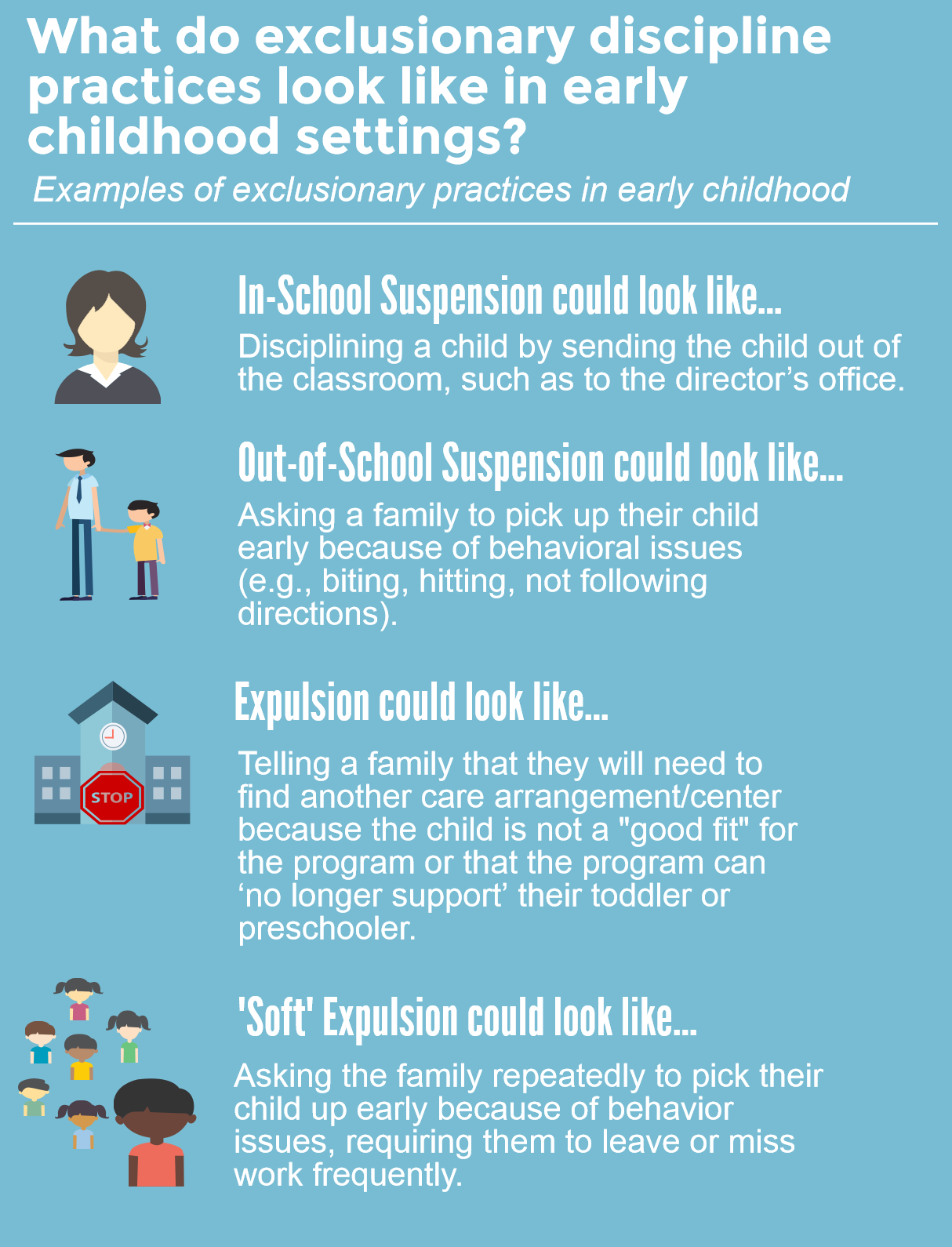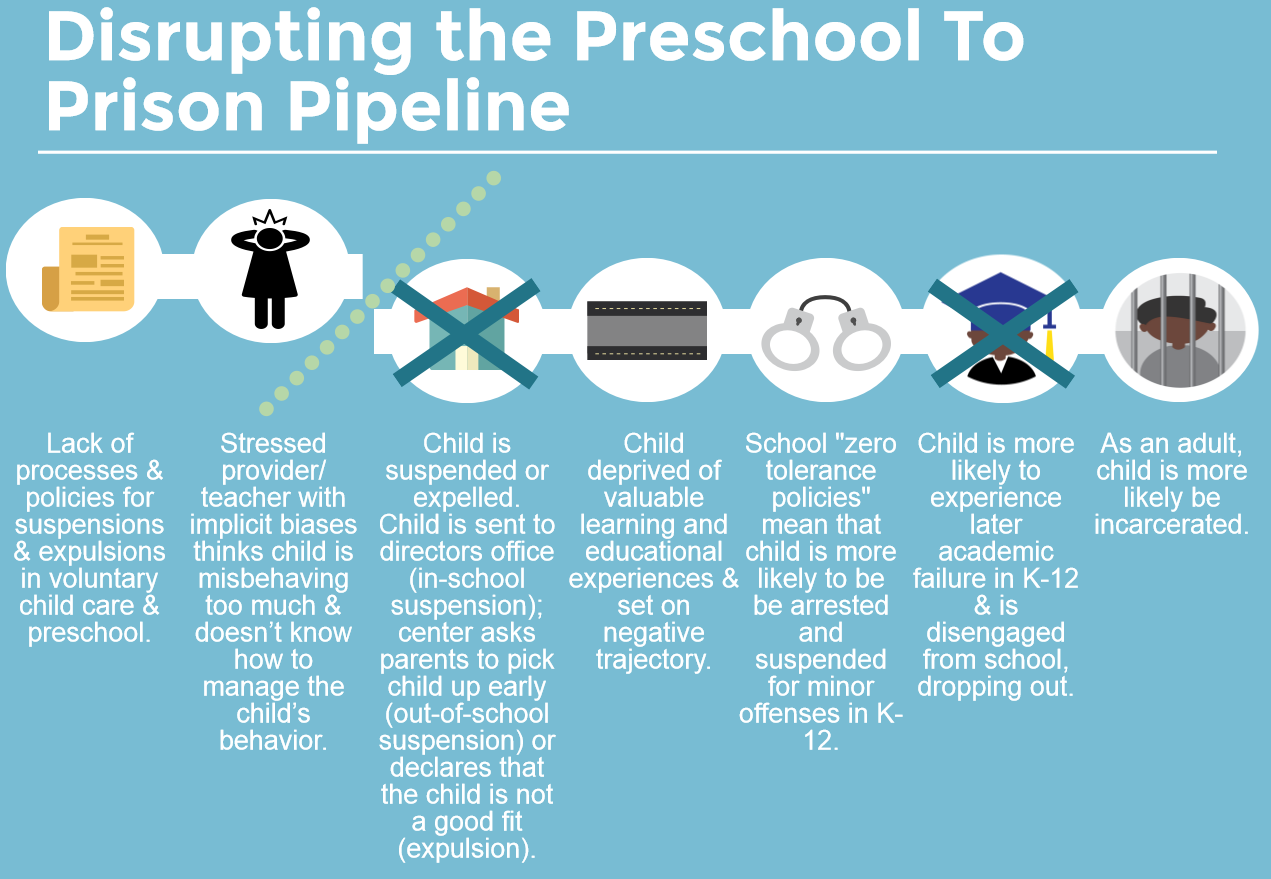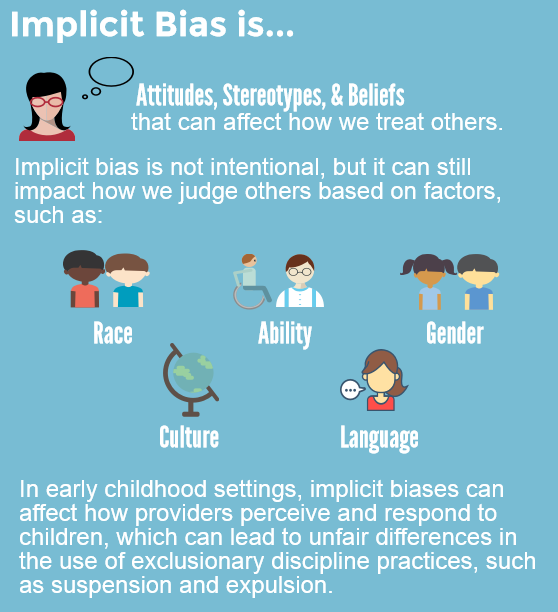What do suspensions and expulsions look like in early childhood settings?

Although we may not label all of our exclusionary discipline practices in early childhood as “suspensions” or “expulsions,” it is important to recognize that they are the equivalent of suspending or expelling a child. Suspensions and expulsions are types of exclusionary practices that involve asking children to leave the classroom, program, or school temporarily or permanently.
- In-school suspensions – Practices that involve removing or excluding the child from the classroom.
- Out-of-school suspensions – Practices that involve temporarily removing the child from the program.
- Expulsions – Permanent removal or dismissal from the program.
- Soft-expulsions – Practices that make it so that the program is not a viable or welcoming care arrangement for the family and leaves the family with little choice but to withdraw their child.
Why is this something we want to avoid?
Recent data indicate that expulsions and suspensions occur regularly in early childhood settings and at a much higher rate than in K-12 education.
Young children (under 5 years old) are expelled at 3 times the rate of K-12 students from state-funded preschool, and private and community child care programs expel children at more than 13 times the rate of K-12 students. Even infants and toddlers are at high risk for child care expulsion. One study found that 42% of infant/toddler care centers in a state reported at least one expulsion in the past year. Based on these estimated rates and the current enrollment of young children in early care and education settings, more than 300,000 children may be expelled each year.
Suspensions and expulsions have profound effects on children.
Walter Gilliam, Director at the Zigler Center in Child Development and Social Policy, explains what we can do to stop preschool expulsions at the “What’s Behind Preschool Expulsion” Congressional briefing, held on June 11, 2015.
Exclusionary discipline practices deprive children of valuable early learning experiences and teach them to believe that there is something wrong or bad about them. When children are excluded from learning environments by being suspended or expelled, they miss valuable educational opportunities and are at greater risk of disengagement and diminished educational opportunities. Such disproportionate trends promote a “preschool to prison pipeline” where young boys and girls are put on the tumultuous track that increases their risk for academic failure, absenteeism, and even incarceration.
Many studies have found that children who are expelled or suspended are more likely to experience academic failure and grade retention, drop out of high school, and face juvenile incarceration than those who are not.
Disparity in discipline begins in preschool.
Exclusionary discipline is disproportionately applied by age, gender, and race.
- Four-year-olds are expelled at a rate about 50% greater than 3-year-olds.
- Boys are expelled at a rate more than 4.5 times that of girls.
- Black children account for almost 50% of public preschool suspensions but less than one-fifth of all preschoolers.
- Black children are also estimated to be 2 times as likely to be expelled as Latino and White children and more than 5 times as likely to be expelled as Asian-American children.
Several studies have found that racial disparities in discipline are not explained by children’s behavior.
That is, black children do not behave any worse than white children; rather they are subject to more harsh discipline for similar behaviors as their peers. Implicit bias and cultural differences in views on discipline strategies and their application to teacher-child relationships play a role in exclusionary discipline practices. Research has found that teachers are more likely to rate relationships with children of their same race/ethnicity more positively. This disproportionality in exclusionary discipline practices may contribute to the preschool to prison pipeline for Black boys in particular. Implicit biases may lead to higher rates of exclusionary practices for Black boys, which in turn deprives these boys of valuable learning and education experiences and sets them on a negative trajectory that increase their risk for incarceration as an adult (the “pipeline”).
Early childhood suspensions and expulsions are not as much a result of child behaviors, as they are related to adult and program characteristics.
This video features the highlights from the “What’s Behind Preschool Expulsion” Congressional briefing, held on June 11, 2015.
Research investigating the factors associated with higher rates of suspension and expulsions find that the key factors relate to the program (e.g., group sizes, child-teacher ratios, and the availability of consultants and support staff to assist teachers with managing challenging behaviors) and the provider/teacher (e.g., teacher depression and teacher job stress), not the child or the child’s behavior. More suspensions and expulsions occur with large group sizes, higher child-teacher ratios, and lack of supports for teachers with regard to managing challenging behaviors, as well as staff characteristics such as depression or sense of job stress.
High expulsion rates are also an indicator that we are not helping families to support their children’s positive social-emotional development that is the foundation for all learning, future relationships, and school readiness. Expelling children may also leave behavioral and developmental concerns unaddressed, potentially depriving children and families of valuable services under the Individuals with Disabilities Education Act (IDEA).
To address this critical issue, the federal agencies and leading national organizations are calling on the early childhood field to take immediate action:
- The U.S. Department of Health and Human Services (HHS) and U.S. Department of Education (ED) issued a Joint Policy Statement on Expulsion and Suspension Policy in Early Childhood Settings and additional resources.
- The new Child Care and Development Block Grant reauthorization requires states to develop policies and plans related to preventing suspension and expulsion of children birth to age 5 in child care and early childhood programs.
- The Head Start Performance Standards clearly prohibit the expulsion of children from Head Start programs and set strict limits on the use of temporary suspension, consistent with long-standing Head Start policy.
- The White House released a new capstone report with updates about projects launched and local progress made in response to the Administration’s Rethink Discipline efforts.
In addition, the following professional groups and organizations have issued policy or position statements or developed web pages dedicated to preventing suspensions or expulsions in early childhood:
- Standing Together Against Suspension & Expulsion in Early Childhood: A Joint Statement drafted by the National Association for the Education of Young Children (signed by more than 30 national organizations, including ZERO TO THREE, National Association for Family Child Care, National Association of Early Childhood Specialists in State Departments of Education, National Association of Early Childhood Teacher Educators, and National Association of State Directors of Special Education)
- The American Academy of Pediatrics Policy Statement on Out-of-School Suspension and Expulsion
- ZERO TO THREE has a page on Preventing Expulsion from Preschool and Child Care
- The American Psychological Association Public Interest Health Disparities Group has devoted a page to Building Blocks for Preschool Success
To find out what efforts are under way in your state or local community, see the following resources:
- State and Local Action to Prevent Expulsion And Suspension In Early Learning Settings (2016) U.S. Department of Health and Human Services, Administration for Children & Families
- Suspension and Expulsion in Preschool Development States: Policies and Practices (2016) Preschool Development Grant Technical Assistance (PDA TA) Program

